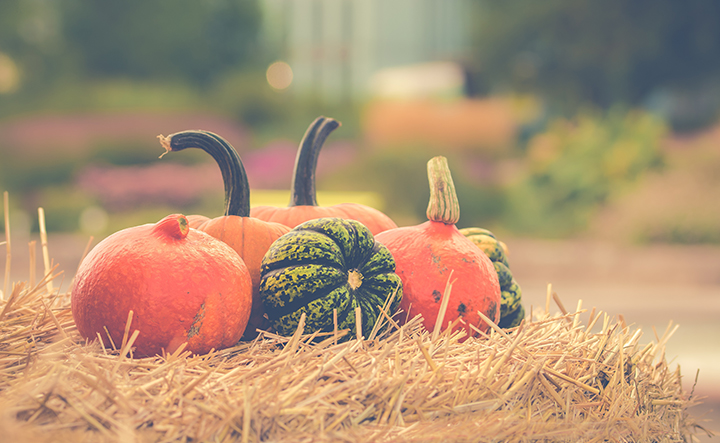For many of us, October is a pumpkin month – let’s give this plant the attention it truly deserves. This stunning squash is considered a “superfood,” a title typically reserved for natural foods that are especially nutrient-dense.
First, a trivia question: is pumpkin a fruit or a vegetable? Since it is a product of the seed-bearing structure of flowering plants, from the botanists’ perspective, it is a fruit. But because pumpkins are less sweet and more savory from a culinary perspective, people categorize them as a vegetable.
Next, let’s look at several (out of many) health benefits, and why we should eat pumpkin more often, all year ‘round, and not only during holiday season.
The Health Benefits of Pumpkin
1. Great for your eyes
“Pumpkin is rich in vitamin A, which is really great for your vision. Just a single serving (about one cup) of pumpkin can provide over 180% of your daily recommended intake of vitamin A. According to naturopathic doctors, pumpkin also contains lutein and zeaxanthin, compounds that protect your eyes from age-related macular degeneration and cataracts.
2. Contains cancer-fighting elements
Yellow, orange and red plants like pumpkins, carrots, squash contain carotenoids, a pigment which combat the effects of free radicals in your body. This may help protect you against some types of cancer.
3. Pumpkin helps you age healthfully.
The same antioxidants that help prevent cancer also help your body fight off the common cold, and ward off all sorts of damage done by free radicals. As a result, you have a better chance to slow down aging and protect yourself from developing chronic conditions, like heart disease and cancer.
4. Healthy for your heart
Pumpkin is high in potassium, which is a key ingredient for heart health. A cup of pumpkin gives 18% of daily recommended amount of potassium. Its heart-healthy vitamin C, fiber and antioxidants can help prevent heart disease and regulate blood pressure.
5. Beneficial for weight loss
If keeping your weight in check is a challenge, add more pumpkin to your diet. It contains just 50 calories per cup, but it gives you a feeling of being full. That same portion also provides three grams of fiber which can trick your body to feel full even longer.
6. Boosts your immune system
A serving of pumpkin contains 25% of the recommended daily intake of vitamin C, an immune booster that helps reduce cell damage from free radicals. Pumpkin also packs a punch when it comes to other immunity-strengthening antioxidants, including vitamin A, vitamin E, and iron.
7. Super-healthy seeds
Don’t throw away pumpkin seeds! Clean, spice and roast them for a nutritious nosh. The health benefits of pumpkin seeds include a reduced risk of cancer, improved bowel and prostate health, and a lower risk of heart disease. Add them to a salad, oatmeal, homemade granola or over yogurt for a little bit of crunch.
Pumpkins with superior taste qualities
There are more than 100 varieties of pumpkins on the market each Fall. How do you pick the best one to bake a delicious pie or make a pumpkin soup? Here is a short list to have your started in selecting your pumpkins with superior taste qualities.
Lakota
A heirloom variety more common in the midwestern states with great flavor and sweet taste. This pear-shaped pumpkin has red skin and black-green striping along with the mild ribbing. These are small to medium sized pumpkins weigh in around 6lbs.
They have a sweet, dense flesh, similar to butternut squash.
Cinderella
These French pumpkins have a fairytale look about them that reminds you of Cinderella’s pumpkin carriage. They have moist flesh, sweet, dense that is ideal for use in pies.
Blue Doll
Greenish-blue pumpkin that grows from 15 to 20lbs in weight. The taste of deep orange flesh will make great pies and soups.
Butternut Squash
This common and popular vegetable can be roasted, sautéed, toasted, puréed for soups such as squash soup, or mashed to be used in casseroles, breads, muffins, and pies.
Want a Roasted Pumpkin Recipe?
There really isn’t any need for a specific recipe for roasting a pumpkin. You can easily create your own recipes. Here are just few tips:
Wash the outside well, dry it, then cut it in half with a large knife. (No need to peel.) Once halved, use a large spoon to scoop out the seeds.
Preheat the oven to 400ºF and spread soften butter over a rimmed baking sheet. Slice your pumpkin into crescents about the width of your thumb and toss them on the baking sheet. They should be in a single layer. (If you have a lot, roast them on two trays, or refrigerate the rest for another day.)
Roast the slices on the lower rack of the oven for 20 to 30 minutes, flipping them midway during baking, until they’re cooked to your liking.
Use your imagination to add extra taste and flavors to your roasted pumpkin:
– You can sprinkle it with coarse sea salt and black or chili pepper.
– You can add some thinly sliced garlic for extra flavor.
– Using fresh thyme, rosemary or sage will make your pumpkin a great side dish.
– Adding cinnamon and brown sugar or maple syrup on your pumpkin to be added to your oatmeal or yogurt.
Pumpkin your life with this magical fruit or vegetable, whatever you prefer to call it!




